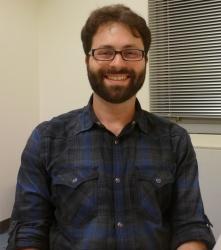News & Events
MSC03 2060
300 Terrace St. NE
Albuquerque, NM 87131-0001
Physical Location:
Clark Hall
Phone: 505-277-6655
chemistry@unm.edu
MSC03 2060
300 Terrace St. NE
Albuquerque, NM 87131-0001
Physical Location:
Clark Hall
Phone: 505-277-6655
chemistry@unm.edu

Profile: Dr. Alexander L. Ayzner moved from Russia to San Francisco. He received a B.S. in Chemistry from the University of San Francisco and his Ph.D. in Physical Chemistry from UCLA. He was a Postdoctoral Scholar at Stanford University in the SLAC National Accelerator Laboratory. He is currently an Assistant Professor of Chemistry at UC Santa Cruz.
Abstract: There is a pressing need to develop inexpensive, light-weight light-harvesting machinery that helps convert the energy of sunlight into chemical potential energy. A grand challenge is to mimic the photosynthetic apparatus found in natural organisms. Though such a task is currently too daunting, Nature inspires us to use self-assembly to construct complex light-harvesting super-systems capable of carrying out the “light reactions” of photosynthesis. To this end, we are using oppositely charged conjugated polyelectrolyte (CPE) complexes as the foundation for an ionically assembled electronic energy transfer antenna. For the first time, we have shown that CPE complexation proceeds through a free energy barrier that appears to have a substantial enthalpic contribution – a result that differs qualitatively from non-conjugated polyelectrolyte complex behavior. Further, we find that upon complex formation, the backbone CPE microstructure is altered in such a way as to qualitatively change the nature of the electronic wave function delocalized along the backbone. Using a combination of spectroscopic and structural probes, our recent work shows that the photo physical changes that accompany complexation are highly dependent on the relative polyion charge ratio. As a result, the energy transfer rate depends very strongly on the ionic stoichiometry and thus the physical state of the assembly. Our results point towards a path to using CPEs to construct truly panchromatic light-harvesting systems using ionic self-assembly.
See Announcement